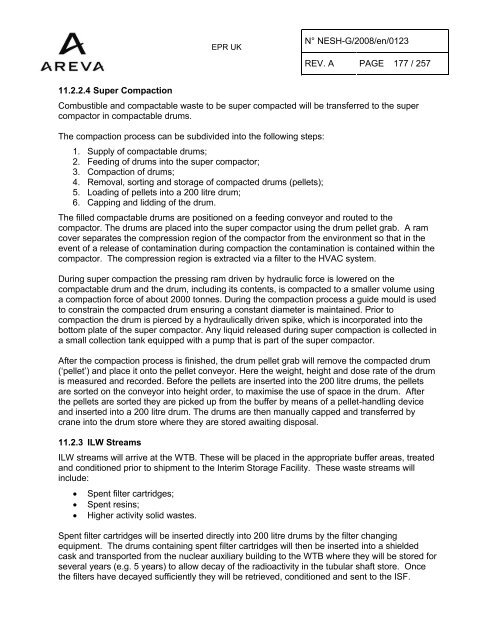Solid Radioactive Waste Strategy Report.pdf - UK EPR
Solid Radioactive Waste Strategy Report.pdf - UK EPR
Solid Radioactive Waste Strategy Report.pdf - UK EPR
Create successful ePaper yourself
Turn your PDF publications into a flip-book with our unique Google optimized e-Paper software.
<strong>EPR</strong> <strong>UK</strong><br />
N° NESH-G/2008/en/0123<br />
REV. A PAGE 177 / 257<br />
11.2.2.4 Super Compaction<br />
Combustible and compactable waste to be super compacted will be transferred to the super<br />
compactor in compactable drums.<br />
The compaction process can be subdivided into the following steps:<br />
1. Supply of compactable drums;<br />
2. Feeding of drums into the super compactor;<br />
3. Compaction of drums;<br />
4. Removal, sorting and storage of compacted drums (pellets);<br />
5. Loading of pellets into a 200 litre drum;<br />
6. Capping and lidding of the drum.<br />
The filled compactable drums are positioned on a feeding conveyor and routed to the<br />
compactor. The drums are placed into the super compactor using the drum pellet grab. A ram<br />
cover separates the compression region of the compactor from the environment so that in the<br />
event of a release of contamination during compaction the contamination is contained within the<br />
compactor. The compression region is extracted via a filter to the HVAC system.<br />
During super compaction the pressing ram driven by hydraulic force is lowered on the<br />
compactable drum and the drum, including its contents, is compacted to a smaller volume using<br />
a compaction force of about 2000 tonnes. During the compaction process a guide mould is used<br />
to constrain the compacted drum ensuring a constant diameter is maintained. Prior to<br />
compaction the drum is pierced by a hydraulically driven spike, which is incorporated into the<br />
bottom plate of the super compactor. Any liquid released during super compaction is collected in<br />
a small collection tank equipped with a pump that is part of the super compactor.<br />
After the compaction process is finished, the drum pellet grab will remove the compacted drum<br />
(‘pellet’) and place it onto the pellet conveyor. Here the weight, height and dose rate of the drum<br />
is measured and recorded. Before the pellets are inserted into the 200 litre drums, the pellets<br />
are sorted on the conveyor into height order, to maximise the use of space in the drum. After<br />
the pellets are sorted they are picked up from the buffer by means of a pellet-handling device<br />
and inserted into a 200 litre drum. The drums are then manually capped and transferred by<br />
crane into the drum store where they are stored awaiting disposal.<br />
11.2.3 ILW Streams<br />
ILW streams will arrive at the WTB. These will be placed in the appropriate buffer areas, treated<br />
and conditioned prior to shipment to the Interim Storage Facility. These waste streams will<br />
include:<br />
· Spent filter cartridges;<br />
· Spent resins;<br />
· Higher activity solid wastes.<br />
Spent filter cartridges will be inserted directly into 200 litre drums by the filter changing<br />
equipment. The drums containing spent filter cartridges will then be inserted into a shielded<br />
cask and transported from the nuclear auxiliary building to the WTB where they will be stored for<br />
several years (e.g. 5 years) to allow decay of the radioactivity in the tubular shaft store. Once<br />
the filters have decayed sufficiently they will be retrieved, conditioned and sent to the ISF.

















